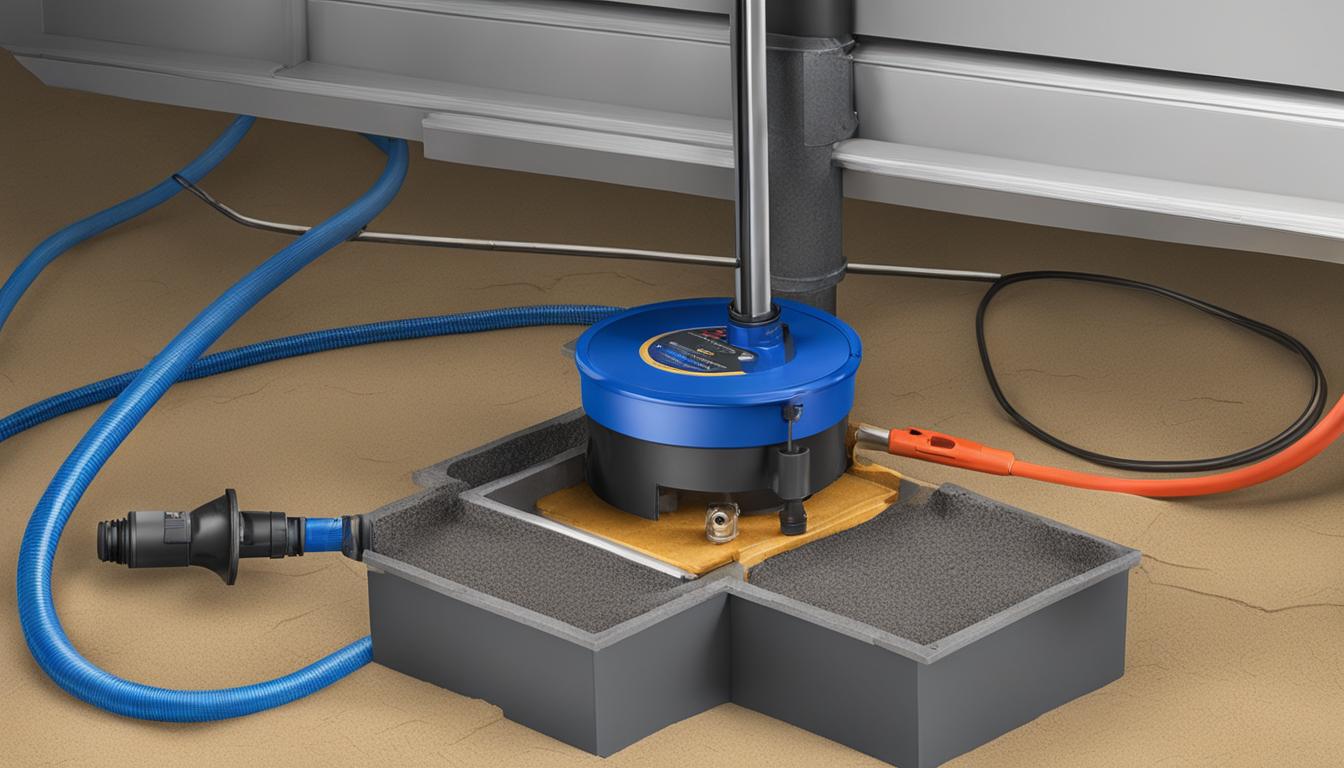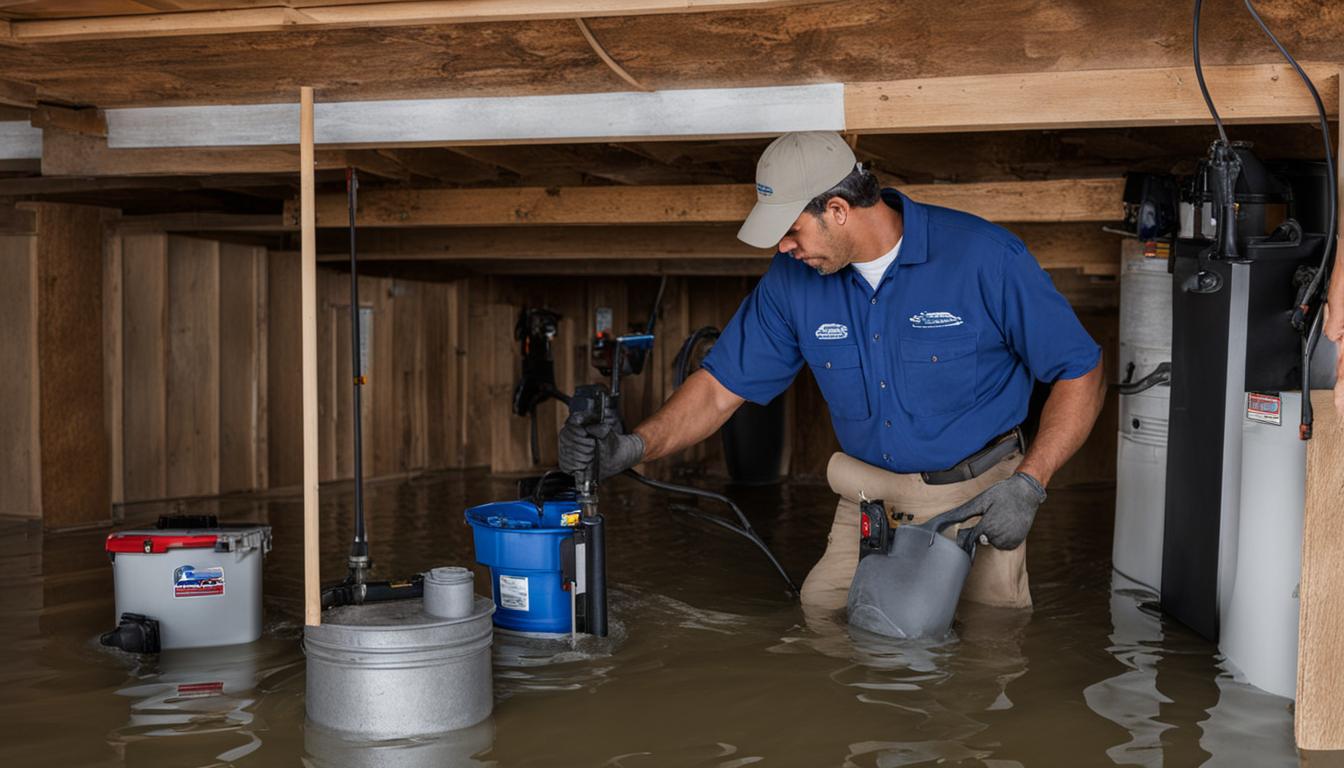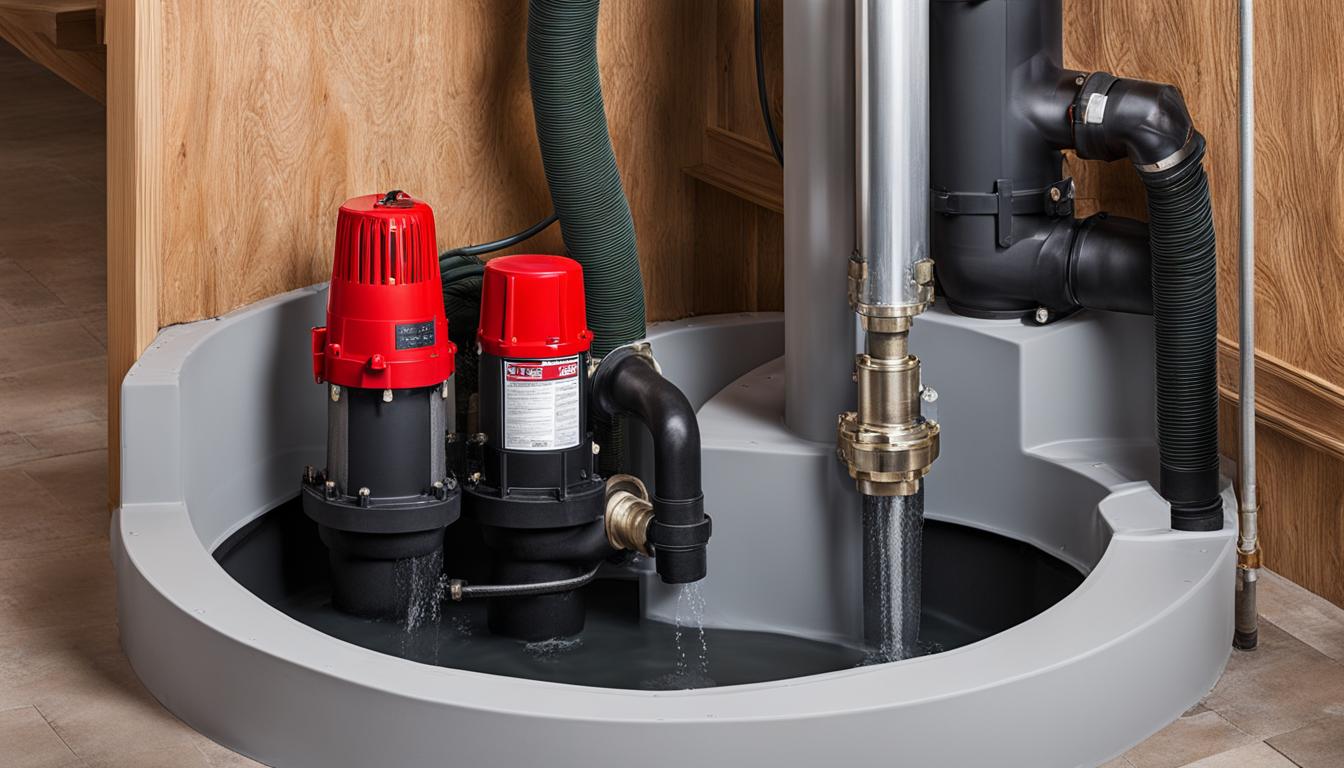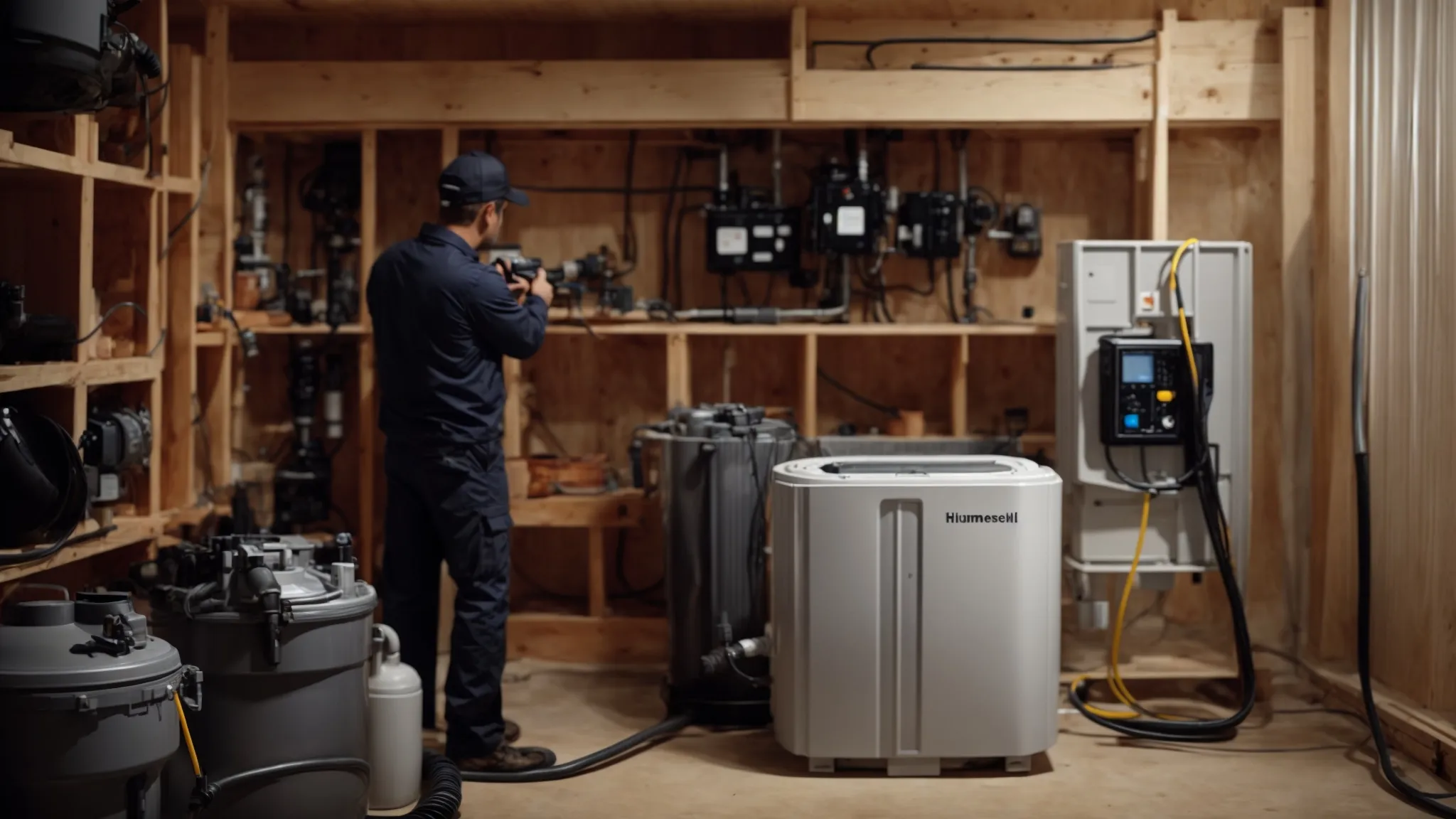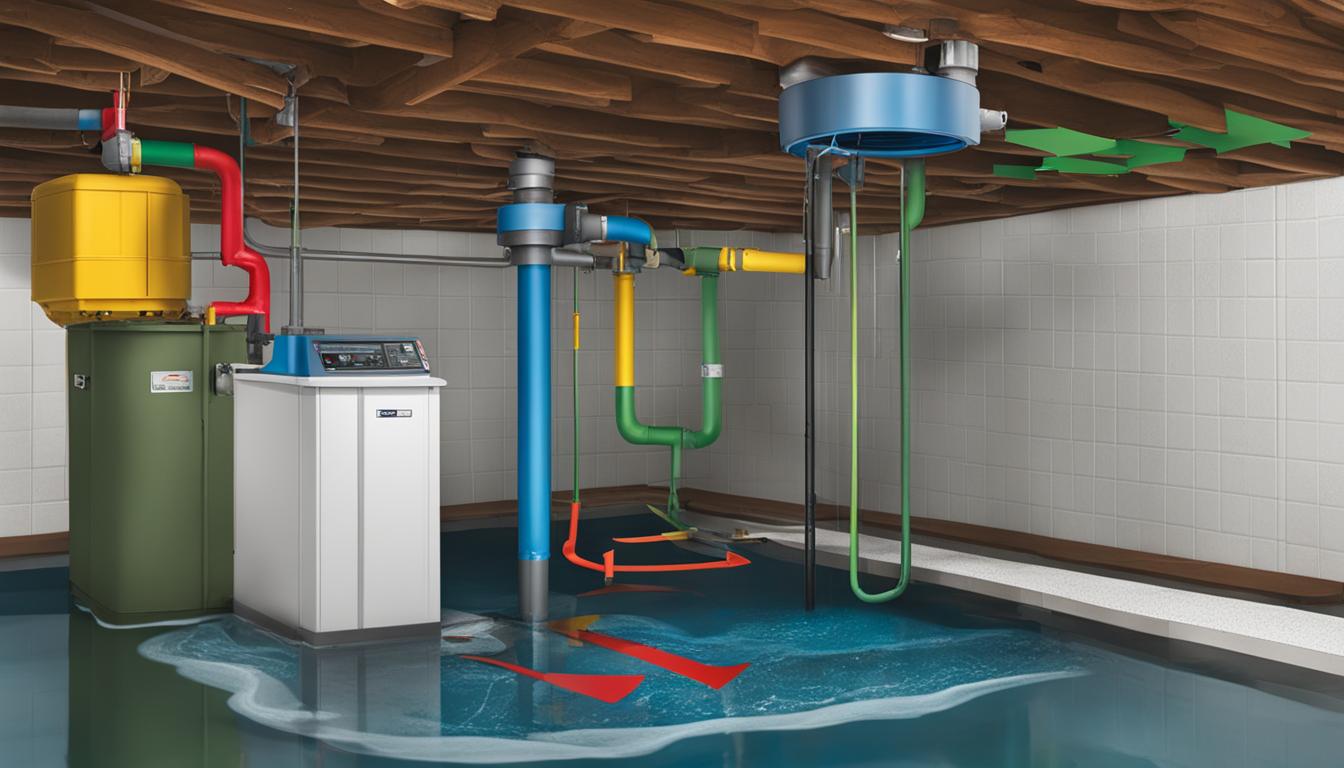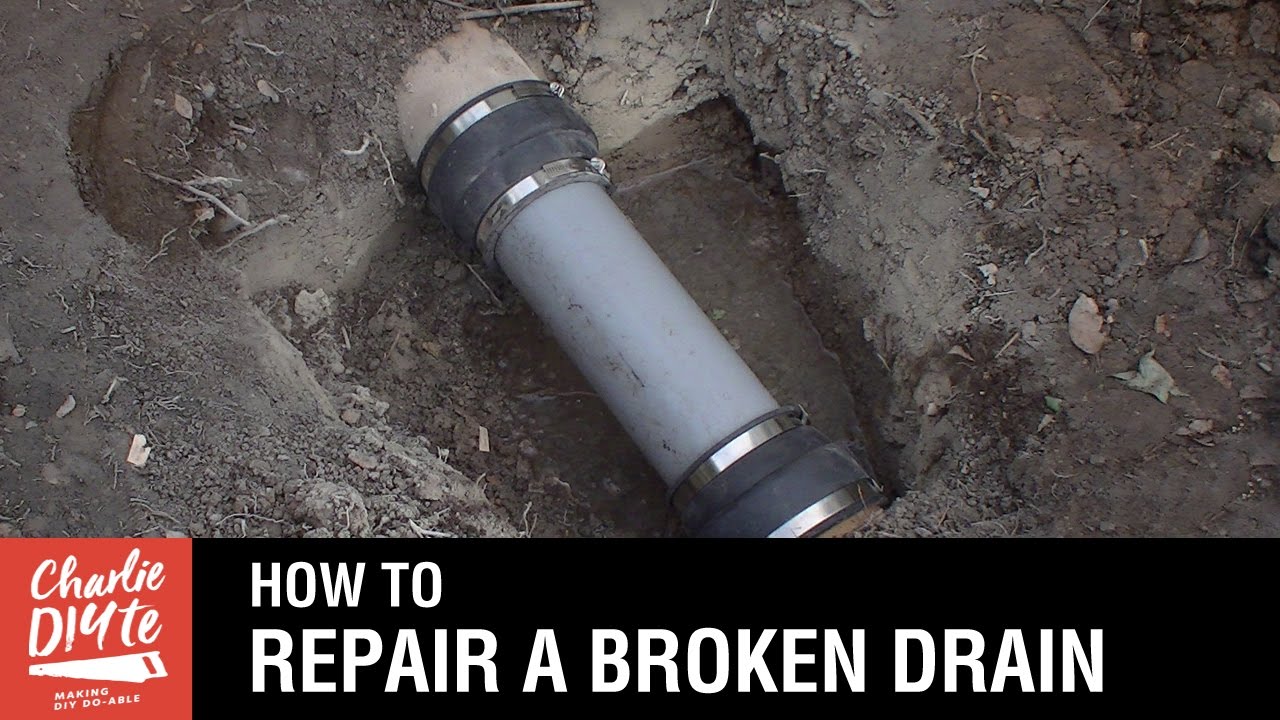Proper installation of a sump pump is essential for protecting your home from water damage. However, common errors during installation can have a significant impact on its functionality and efficiency. That’s why it’s important to follow expert advice and avoid installation mistakes to ensure high-quality and effective sump pump setup.
Key Takeaways:
- Expert advice is crucial for avoiding common sump pump installation mistakes.
- Improper installation can affect the quality and efficiency of your sump pump.
- Proper installation includes ensuring correct sizing and capacity, proper discharge pipe installation, and regular maintenance.
- DIY installation can lead to various challenges, and hiring a professional can ensure a higher level of expertise.
- By avoiding common installation mistakes, you can protect your home from water damage and enjoy efficient sump pump operation.
Understanding the Importance of Proper Installation
At [company name], we understand that proper sump pump installation is essential for preventing water damage and keeping your basement dry. In this section, we will discuss the key factors that contribute to installation quality, highlight common setup pitfalls, and provide prevention tips to avoid them.
Factors Contributing to Installation Quality
The following key factors contribute to installation quality:
- Proper sizing and capacity: Choosing the right sump pump size and capacity is vital to ensure it can handle the expected water volume. An undersized sump pump can cause it to overwork and fail, while oversized sump pumps can lead to a shorter lifespan and increased energy costs.
- Correct location: The location of your sump pump can significantly impact its performance. The pit should be located in the lowest point of your basement, and the discharge line should be appropriately placed to avoid recirculation of water.
- Discharge pipe installation: The discharge pipe is often overlooked, but it can cause significant issues if not installed correctly. It must be properly sloped and secured to avoid leaks and blockages.
Common Setup Pitfalls
The following are common setup pitfalls that homeowners encounter:
- Insufficient pit size: A pit that is too small can cause your sump pump to work harder and fail prematurely. Ensure that your pit is large enough to accommodate the sump pump.
- Improper discharge pipe installation: As previously noted, an incorrectly installed discharge pipe can lead to leaks and blockages, which can cause the sump pump to fail. Ensure that the discharge pipe is correctly sloped and secured.
- Power source: Your sump pump should always be connected to a dedicated electrical circuit. Avoid using an extension cord, which can cause electrical issues and create a safety hazard.
Prevention Tips
Follow these prevention tips to avoid common installation pitfalls:
- Get professional help: Hiring a professional for sump pump installation ensures a higher level of expertise, reducing the risk of common errors. A reputable sump pump installation company, like [company name], will ensure that your sump pump is installed correctly, and your home is protected from water damage.
- Regular maintenance: Regular maintenance and inspections are essential to keep your sump pump in optimal condition. Make sure to follow the manufacturer’s maintenance instructions carefully.
- Test regularly: Testing your sump pump ensures that it is working correctly when needed. Test your sump pump regularly and address any issues immediately.
Choosing the Right Location for Your Sump Pump
Proper placement is crucial to ensure a sump pump functions effectively and efficiently. Avoiding common installation mistakes related to location is essential to ensure your sump pump system serves its purpose.
One of the most common setup pitfalls is placing the sump pump in a location that is difficult to access for maintenance and repairs. It’s important to choose a location that is easily reachable, preferably in a crawlspace or basement, where excess water can collect and drain out.
Another mistake homeowners make is not factoring gravity into the equation. The discharge pipe should have adequate slope to ensure water is flowing out of your home efficiently. If the pipe is flat or has an uphill slope, water can accumulate and cause further complications.
Our expert advice is to choose a location that is not near any heat source, such as a furnace or water heater. The sump pump should be placed in an area that minimizes noise and vibration. Isolating it from living spaces or bedrooms is highly recommended.
Choosing the Right Spot for Your Sump Pump
When it comes to choosing the right spot, there are a few factors to consider:
- Accessibility for maintenance and repairs
- Adequate slope for discharge pipe
- Distance from heat sources
- Noise and vibration level
| Common Location Mistakes | Proper Location Tips |
|---|---|
| Installing the sump pump in a low-lying location that causes water to accumulate around the foundation. | Place the sump pump in a high spot where water can easily drain out. |
| Putting the sump pump close to the furnace or water heater. | Choose a location that is not near any heat source. |
| Placing the sump pump in a common living space, leading to noise and vibration. | Choose an area isolated from living spaces or bedrooms. |
By avoiding installation mistakes related to location, homeowners can ensure that their sump pump system operates at maximum efficiency, protecting their homes from water damage and avoiding costly repairs.
Ensuring Proper Sizing and Capacity
One of the essential factors for proper sump pump installation is ensuring the correct sizing and capacity. A sump pump that is too small won’t be able to handle the expected water volume, while an oversized one can be costly and inefficient.
Expert advice: To determine the right capacity for your sump pump, consider the amount of water that may enter your basement or crawl space during heavy rainfall. Typically, a sump pump should be able to pump out 2,200 to 3,000 gallons per hour. Consult with a professional to help you determine the appropriate capacity for your specific needs.
| Issues caused by improper sump pump size: | Corrective measures: |
|---|---|
| Overflowing sump pit | Check the pump’s discharge pipe size and ensure it’s not clogged |
| Short cycling | Adjust the float switch or install a larger pump |
| Excessive energy consumption | Install an appropriate-sized sump pump to avoid energy waste |
Proper sizing and capacity contribute significantly to the operational efficiency of your sump pump system. It ensures your sump pump can handle the expected water volume and reduces the risk of clogs, overflows, and other related issues.
Determining the Right Horsepower for Your Sump Pump
The horsepower (HP) of your sump pump is another critical factor in ensuring proper sizing and capacity. Generally, sump pumps range from 1/6 to 1/2 HP, and the higher the HP, the more water it can pump out per hour. However, a higher HP also results in higher energy consumption.
Expert advice: The appropriate horsepower for your sump pump depends on the size of your basement or crawl space and the expected water volume during heavy rainfall. A professional can help you determine the right HP to avoid energy waste and maximize efficiency.
By ensuring proper sizing and capacity for your sump pump, you can avoid potential issues and improve its operational efficiency. Consult with a professional to determine the appropriate capacity and horsepower for your specific needs.
Proper Discharge Pipe Installation
While often overlooked, the installation of the discharge pipe is critical to your sump pump system’s efficient operation. Incorrect installation can lead to setup pitfalls, and troubleshooting can become challenging. To ensure proper installation, we will highlight common installation mistakes related to the discharge pipe and provide expert advice on how to avoid them.
Common Installation Mistakes
One of the most common installation mistakes related to the discharge pipe is the use of incorrect pipe size or materials. Using an inadequate diameter pipe can cause the sump pump to work harder, leading to premature wear and tear. Additionally, if the pipe is too long or has too many twists and turns, there will be increased resistance, causing the pump to work harder and longer, reducing its efficiency.
Another common mistake is the improper installation of the check valve. The valve prevents water from flowing back into the sump pit, but it only works when correctly installed. If the valve is installed backward or malfunctions, water can flow back, causing the pump to work harder and increasing the risk of failure.
Troubleshooting Tips
If you notice any issues with your sump pump system, the discharge pipe is an excellent place to start troubleshooting. Check for any leaks or blockages in the pipe, which can cause the pump to work harder and reduce its efficiency. Additionally, ensure that the check valve is correctly installed and functioning correctly. These troubleshooting steps can help prevent setup pitfalls and extend your sump pump’s lifespan.
Expert Advice for Proper Installation
To ensure proper discharge pipe installation, consider hiring a professional for sump pump installation. A professional can help you choose the right pipe size and materials, properly install the check valve, and ensure that the pipe is the optimal length and has enough clearance to avoid any obstructions. This expert advice can help prevent installation mistakes and setup pitfalls and ensure the long-term efficiency of your sump pump system.
Testing Your Sump Pump System
Properly testing your sump pump system is an essential step to ensure it will function effectively during heavy rainfalls. Neglecting to test your system can lead to severe consequences, including water damage to your basement or crawl space.
At [Company Name], we recommend testing your sump pump system at least once a year, ideally before the rainy season begins. Follow our expert advice on how to test your sump pump system effectively:
- Check the power supply: Before beginning the test, make sure the sump pump is plugged in and the electrical circuit is working correctly.
- Fill the sump pit with water: Pour water into the sump pit until the float activates the pump. This test will simulate a heavy rainfall and will allow you to test the efficiency of your pump.
- Monitor the discharge pipe: During the test, monitor the discharge pipe to ensure the water is being pumped away from your house. If the pipe is not discharging water correctly, it may be clogged or installed improperly.
- Inspect the pump: Once the test is complete, inspect your sump pump for any signs of damage or wear and tear. If you notice any issues or abnormalities, call a professional to ensure proper repairs are made.
By following these expert tips for testing your sump pump system, you can help prevent water damage and ensure your sump pump is operating effectively. Don’t neglect this essential step in maintaining your home’s safety and security.
Regular Maintenance and Inspections
Regular maintenance and inspections are essential to ensure the proper functioning of your sump pump system. Neglecting these tasks can lead to operational inefficiencies and potential failure, resulting in costly repairs and water damage to your home.
Our expert advice: Make it a habit to perform regular inspections and maintenance tasks on your sump pump system. Set a reminder on your calendar to inspect your sump pump at least twice a year, preferably in the spring and fall.
| Inspection Tasks | Recommended Frequency |
|---|---|
| Clean sump pit and remove debris | Twice a year |
| Check discharge pipe for leaks and proper connections | Twice a year |
| Test sump pump operation | Once a month |
| Replace backup battery (if applicable) | Every 2-3 years |
During the inspection, check the sump pump for any signs of wear and tear, damage, or loose connections. Replace any worn or damaged parts promptly. If you notice any unusual sounds or vibrations, it could indicate an issue with the sump pump, and it’s best to seek professional help.
Operational efficiency tip: A properly maintained sump pump system operates more efficiently, saving you money on energy and repair costs. Don’t neglect regular maintenance and inspections!
Common DIY Challenges and How to Overcome Them
While installing a sump pump yourself can be cost-effective, it can also come with various challenges. Here are some common DIY challenges you may encounter when installing a sump pump and the corrective measures and troubleshooting tips you can take to overcome them.
Challenge 1: Improper Sump Pit Installation
Improper sump pit installation can lead to various issues, such as water seepage and groundwater infiltration. To avoid this, ensure that the sump pit is at least 18 inches in diameter and 24 inches deep. The pit should be dug into undisturbed soil and lined with gravel to promote proper drainage.
Corrective Measure: If the sump pit is not installed correctly, excavation may be necessary to fix the problem. Ensure that the pit is installed at the correct level, with a slight slope towards the discharge pipe.
Challenge 2: Incorrect Pump Sizing
Choosing the wrong pump size can result in an inefficient or overworked sump pump system. Before purchasing a sump pump, determine the water volume and head pressure to ensure that the pump is properly sized.
Corrective Measure: If you have already purchased the wrong pump size, consider exchanging it for the right size. If you are unsure which pump size to choose, consult a professional to help you make the correct selection.
Challenge 3: Improper Discharge Pipe Installation
The discharge pipe installation is often overlooked in DIY sump pump installations, leading to issues such as clogs and pipe damage.
Corrective Measure: Ensure that the discharge pipe is installed correctly by using the proper materials, including PVC or ABS pipe. Properly secure the pipe connections and ensure that the pipe is sloped away from the sump pit to promote proper water flow. Regularly inspect the discharge pipe to ensure it is free from debris and clogs that could prevent proper water flow.
Challenge 4: Inadequate Power Supply
A sump pump system requires a reliable power supply to function correctly. Power outages or electrical surges can damage the pump or cause it to shut off.
Corrective Measure: Consider installing a backup power source, such as a battery-powered backup sump pump, to ensure the system continues to function even during power outages. Regularly check the power supply to ensure it is functioning correctly and replace any damaged components promptly.
Challenge 5: Poor Maintenance
Regular maintenance is essential to keep a sump pump system functioning efficiently. Neglecting maintenance tasks can lead to issues such as clogs and pump failure.
Corrective Measure: Regularly inspect the sump pump and discharge pipe for any signs of damage or wear. Clean the sump pit and check the pump’s components for any signs of wear or damage. Replace any damaged components promptly to ensure the system continues to function correctly. Consider scheduling an annual professional inspection to ensure optimal system performance.
While DIY installation can be challenging, properly installing a sump pump can protect your home from water damage and save you money on repair costs in the long run. If you encounter any of these or other challenges during installation, don’t hesitate to seek professional help. With the correct installation and regular maintenance, your sump pump system should provide reliable protection for many years to come.
Hiring Professional Help for Sump Pump Installation
While it’s possible to install a sump pump yourself, it’s essential to consider hiring a professional to ensure proper installation. By doing so, you can have peace of mind knowing that your sump pump is installed correctly and will operate efficiently when you need it most.
Expert advice is essential to ensure installation quality, especially if you’re unfamiliar with sump pump installation. It’s common to make mistakes during the installation process, which can lead to common errors that affect your sump pump’s efficiency. Professional installation can help prevent these errors and provide you with a reliable, efficient sump pump system.
Professional installation also ensures that your sump pump is installed in compliance with local regulations, reducing potential problems down the road. Additionally, a professional can provide advice on sump pump models and brands, ensuring that you select a system that meets your needs and budget.
When you hire professional help for sump pump installation, you can rest assured that the work is done correctly and up to industry standards. You won’t have to worry about potential problems or issues that could arise from DIY installations, saving you time, effort, and money in the long run.
Overall, if you’re unsure of your ability to install a sump pump correctly, or if you want to avoid common errors and ensure installation quality, seeking the help of a professional is the best option. Our team of experts can provide you with the knowledge and experience you need to ensure proper sump pump installation and optimal performance for years to come.
Conclusion
At [company name], we understand the importance of proper sump pump installation to protect your home from water damage and ensure the efficient operation of your system. We hope that this article has provided you with valuable insights on how to avoid common installation mistakes and achieve a high-quality setup.
Remember, proper installation involves several factors, including choosing the right location, sizing and capacity, and correct pipe installation. Testing your system and performing regular maintenance and inspections are also critical to keep your sump pump functioning correctly.
Professional Help for Sump Pump Installation
While some homeowners choose to install their sump pumps themselves, hiring a professional can help ensure a higher level of expertise and reduce the risk of common errors. Our team of experts is always ready to help with your sump pump installation needs.
Thank you for choosing [company name] for your sump pump needs. Contact us today with any questions or to schedule an appointment with one of our professionals.
FAQ
What are some common sump pump installation mistakes to avoid?
Some common sump pump installation mistakes to avoid include improper sizing, incorrect placement, inadequate discharge pipe installation, and neglecting regular maintenance and inspections.
Why is proper sump pump installation important?
Proper sump pump installation is crucial for ensuring the quality and efficiency of your sump pump system. It helps prevent potential setup pitfalls and ensures optimal operational performance.
How can I choose the right location for my sump pump?
When choosing the location for your sump pump, consider areas prone to water accumulation, such as basements or crawl spaces. Avoid placing it in low-lying areas or near obstructions. Consult an expert for guidance.
How do I determine the proper sizing and capacity for my sump pump?
To determine the right sizing and capacity for your sump pump, consider factors such as the area’s average rainfall, the basement’s size, and the expected water volume. Seek expert advice to ensure accurate calculations.
What should I keep in mind when installing the discharge pipe for my sump pump?
When installing the discharge pipe, avoid common mistakes like using incorrect pipe size, improper slope, or inadequate sealing. These can lead to clogs or water leakage. Proper installation ensures efficient functioning.
How should I test my sump pump system?
Testing your sump pump system involves pouring water into the sump pit to activate the pump. Ensure it starts, runs smoothly, and effectively discharges water. Test it regularly to identify any issues and address them promptly.
Why is regular maintenance and inspections important for my sump pump?
Regular maintenance and inspections help identify potential issues before they become major problems. Check the pump, clean the sump pit, and ensure proper drainage. Inspect the float switch, check valves, and backup power systems if applicable.
What are some common DIY challenges with sump pump installation?
Common DIY challenges include incorrect installation of components, improper setup, and troubleshooting issues. It is important to follow proper guidelines, seek expert advice, and have corrective measures in place.
When should I consider hiring a professional for sump pump installation?
It is advisable to hire a professional for sump pump installation if you are unsure about your DIY skills, dealing with complex setups, or want to ensure top-quality installation. Professionals offer expertise and minimize common errors.
How can proper sump pump installation protect my home?
Proper sump pump installation protects your home by effectively managing water accumulation, reducing the risk of basement flooding, and preventing water damage. It ensures peace of mind and a well-functioning system.
